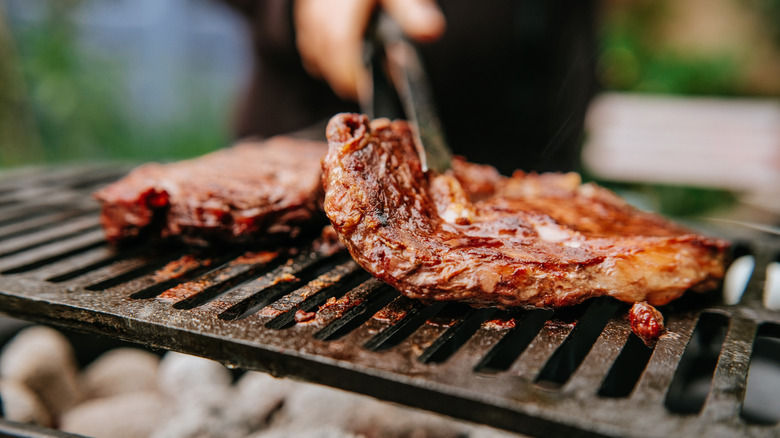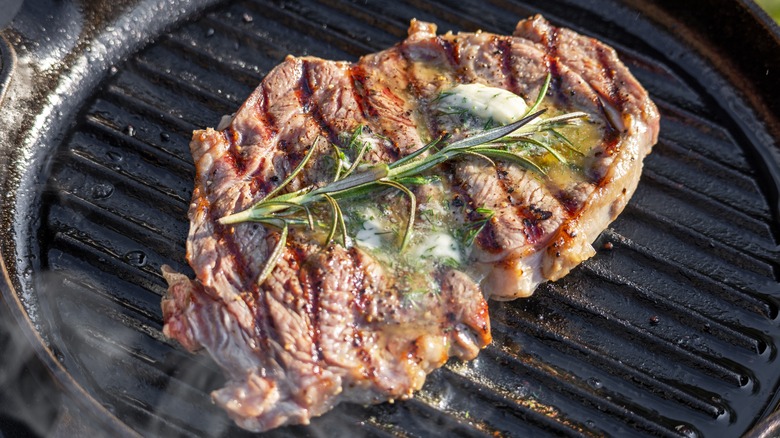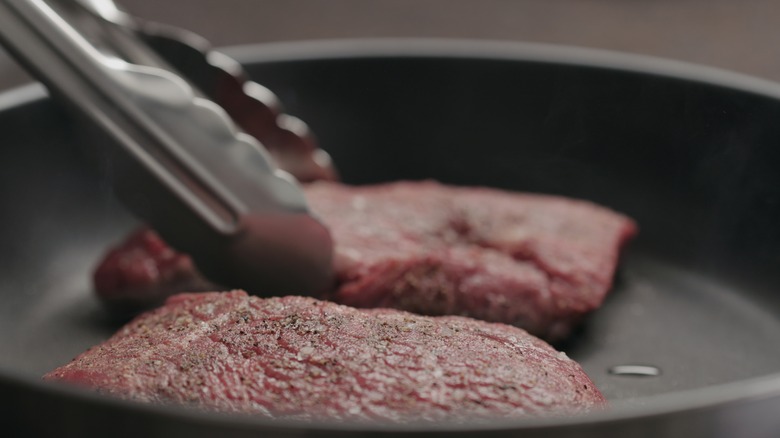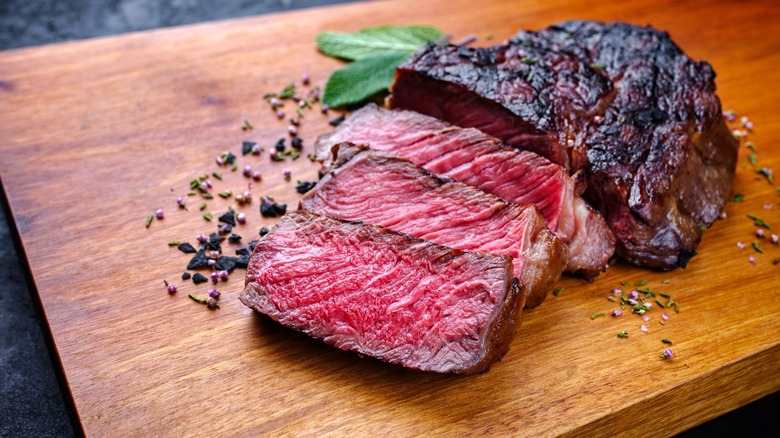5 Best Ways To Cook Steak And 5 You Should Avoid
Achieving an absolutely perfect steak requires a combination of knowledge and good technique. You'll need to know the different cuts of steak to buy, for example, and when to season your meat. Mostly, though, it comes down to how you cook your favorite cut.
That's where things get confusing, because you'll find conflicting advice from chefs, online influencers, TV personalities, food-science writers, and just about every friend who gathers around your grill. Everyone has their own preferred method, and most of them turn out an acceptable steak. Some are just better than others, that's all.
I'm a trained chef and former restaurateur myself, and something of a food-science geek. I've cooked a lot of steaks over the years, and that combination of personal experience and theoretical knowledge means that I can speak to most of the best-known methods with some authority. I'll mostly talk about thick steaks here (say, 1½ inches or more), but I'll explain how these techniques translate to thin steaks as well.
Do: Reverse-sear your steak
For perfectionists, the enemy in steak cookery is what's called "the gradient." Many steaks are served with a nicely seared exterior, then a gray layer of medium or well-done beef, and then in the middle the actual level of doneness you were hoping for (perhaps medium-rare). That's what the gradient is, and eliminating it is the holy grail of preparing perfect steaks.
The reverse-sear is a very effective cooking method to prevent a gray ring around your steak and minimize the gradient. You'll start your steak in a moderately heated oven, or on the cool side of your grill, and then when it's nearly at your preferred temperature, you'll give it a quick, hot sear to finish it off. The reverse-sear is the best and most versatile steak-cooking technique for home cooks.
You may recognize this as the exact opposite of one classic technique, calling for searing your steak first and then finishing it in the oven. That's where the term "reverse-sear" comes from. There are a lot of benefits to reverse-searing steak instead of the other method. You'll get a genuinely superior sear, you'll have a lot more control over the doneness of your steak, and there'll be little or no gray beef under that nicely charred crust. Even if you've cooked your steak a little more than you'd intended while in the oven, you can compensate by chilling it for a few minutes before the sear. That way you can still get your preferred doneness, and very little gradient.
Don't: Start in a skillet, finish in the oven
This is going to come as a shock to a lot of you, and probably ruffle some feathers, because this very method is often touted as the best option for home cooks. Many use it and swear by it, and skilled cooks still endorse the technique; it's one of Ina Garten's tips for cooking perfect steaks. That's why I'm giving it pride of place here, as the "best of the rest" among steak-cooking methods.
Here's the thing. This isn't a bad technique, and in fact, it's a genuinely good one. Its only flaw is that the reverse-sear method offers all of the same advantages and then some, and eliminates this method's flaws. Which flaws, you ask? Well, there are a few, and they're important.
First, heat penetrates your steak from the outside. That means the heat from the oven (and the hot skillet) must continue cooking the already-seared outside, before getting to the inside. That's a formula that almost guarantees a layer of gray under the sear. Second, it's more work to control the doneness this way. You'll need to open the oven frequently to check the steak with a thermometer, which lets out heat and slows cooking. And finally, even if you pat steak dry before cooking it, the meat will still have more surface moisture than a steak coming out of the oven. That translates to less sear, and less surface flavor. So yeah, reverse-sear is the better method.
Do: Sous vide your steaks
Since the turn of the century, the use of sous vide cookery has migrated from industrial food manufacturing to avant-garde chefs to home cooks. The concept is simple: You seal your food in a plastic bag, and then cook it in a water bath at exactly the temperature you want it to be when it's done.
Sous vide steak comes out brilliantly. Your steak stays in the hot bath until it reaches the preset temperature, usually just below final doneness. Then you open the bag, give the steak a quick, hard sear, and serve it. No other technique gives you sous vide's perfect edge-to-edge doneness, with almost no gradient. When you cook for a crowd, you can use a picnic cooler for your water bath and have dozens of steaks needing no more than a quick sear before they hit the plate.
There are a couple of downsides to sous vide. First, because your steak cooks in a sealed bag, its surface doesn't dry, and therefore it won't take a perfect sear. Second, if you don't follow the instructions properly, there's a risk of foodborne illness, because of the low-temperature cooking. Finally, steaks that spend too long in the bath can develop an oddly soft texture. That's disappointing when you splash out the cash for a nice ribeye, but there's an upside: You can buy cheap chuck or other tough cuts, and sous vide them until they're as tender as a higher-priced cut.
Don't: Freeze and deep-fry steaks
With the success of sous vide, a lot of food scientists, influencers, and chefs have been looking for other tech-forward, science-minded ways to crank out a really great steak. One method that's gone viral calls for freezing your steak and then deep-frying it. In fairness, there is some method to this apparent madness. Deep-frying a steak inarguably gives it a beautifully seared and browned crust, and freezing the beef makes for a more tender fried steak (though tenderness won't be an issue with good steaks, anyway).
The methodology varies from one source to another, but it always involves a lot of steps. Usually you'll season your steak, sear it or deep-fry it, freeze it overnight, take it out, blot it dry, and deep-fry it again to refresh the seared crust on the outside. If you do everything right, you will indeed end up with a pretty good steak.
That said, there are a lot of downsides to this method. The first is its complexity (presenting a lot of opportunities for things to go wrong), and a second is the time required — usually 30 to 40 hours. That's a lot, and it involves plenty of hands-on effort. Then there are the complications and mess of deep-frying (not to mention the cleanup). Worse yet, it's easy to overcook your steak in the fryer, and you won't have the juices to use in a pan sauce. Frankly, this method is more trouble than it's worth.
Do: Use your grill
Okay, this is an easy choice, because it's what most of us do. Grilling is familiar to most of us, and it's common to cook steaks this way. The trick is learning how to use your grill most effectively. Just slapping a steak over the hot flame (or coals) is fine for thin cuts, which need to get a quick, hot sear — but doing that is a recipe for heartbreak with a nice, thick steak, because different cuts of steak require different grilling methods.
Instead, set up your coals for the two-zone grilling method, with one side hot and one much cooler. Start your steaks on the low-heat side, cooking them with the lid down and turning them regularly (because one side is always closer to the heat, and you want them to cook evenly). Once the steaks are nearly at your desired doneness, transfer them to the high-heat side for that last sear. You may have just read that and are now thinking, "Hey, isn't that just 'reverse-sear' adapted for the grill?" If so, you're absolutely correct.
All of the advantages I've already cited for the reverse-sear method are equally applicable when you do it on the grill. You'll get more even cooking, your perfect level of doneness through more of the steak, and less of a gradient. More importantly, the low-and-slow cooking style allows time for much of the steak's internal fat to soften and render. Your steaks will seem juicier, and they'll require less chewing as a result.
Don't: Use a grill pan
I have a conflicted relationship with grill pans. I own two of them, and I use them, but they're not my favorite cooking tools, and they're certainly not great for steaks. Let's take a look at how they work.
For steaks, the technique is to get your pan screaming hot, and then plop your beef down on the pan's ridges. The ridges make direct contact with the steak and make hard-seared grill lines, while the heat radiating from the body of the pan slowly cooks the rest of it. It takes a while, and the results are middling at best. You'll have a poor sear over much of the steak, and a fairly large gradient. Realistically, about the only thing you can say in its favor is that it does give you an approximation of grill marks on steak.
Those marks are fine, I guess, but wouldn't you rather have the whole surface of your steak deeply browned? Browning adds flavor, so choosing a pan that only browns a small part of your steak's surface means that you may be missing out on flavor. You can compensate by rotating your steak as it cooks, so the ridges sear more of the surface, but it's better to just choose a more suitable pan.
Do: Cook steaks in a cast-iron skillet
Aluminum and copper make great cookware because they conduct heat so well. Cast iron, carbon steel, and stainless steel are the opposite: They make great cookware because they retain heat so well. They take a lot longer to heat, but they hold that heat and use it to deliver a top-quality sear.
If you're used to nonstick skillets, old-school cast iron requires a mental adjustment. To prevent steak from sticking to a cast-iron skillet, heat the pan first, then add the oil, and only lay down your steak once the oil is hot. A well-seasoned cast-iron pan is reasonably nonstick, but following those steps in that order helps a lot. Once the steak is in the pan, forget the old rule about only turning it once so you get a good crust. You'll get a better crust with a minimal gradient if you flip your steak frequently.
If you want a really memorable meal, always baste your steak with butter. Tilt the skillet so the steak is at the top and drop a tablespoon of butter into the lower part of the pan. Add garlic and herbs to the butter, if you wish. Now, start spooning the hot, rapidly browning butter over the steak. This helps create an extra-deep, flavorful crust on the steak, and the flavorful browned butter (with herbs removed) makes a pleasing sauce for your steak and side dishes. This is also a great way to finish a sous-vide steak.
Don't: Fry steaks in a nonstick skillet
This is another recommendation that's going to raise some hackles, because a lot of people only buy nonstick pans. They're genuinely good and useful tools, but they're not the right choice for steak. Let me explain why.
First, steaks sear best in a pan that's been preheated until it's really hot. Attempting to do this with a nonstick pan will quickly damage its special coating. Second, nonstick pans tend to be made of lightweight aluminum. That means they're likely to warp when they're preheated, but more importantly, they don't retain heat well. When you put your steak into the skillet, its temperature drops rapidly as a result. You just don't get a good sear that way.
The reason old-school skillets help give a good sear is that the steak does stick, just a little, when it first hits the pan. The steak and the pan's surface will part company readily enough a few moments later, as a crust forms and the meat's cells contract in the heat, but in the interim the steak takes on a really nice sear. Nonstick pans, by definition, also deprive you of those flavorful stuck-on browned bits, known to chefs as the "fond" (a French term that means something like "foundation"). There's a lot of flavor in the fond, and it adds extra flavor when making a pan sauce, which is another reason to use cast-iron rather than nonstick skillets.
Do: Broil your steaks
When was the last time you used your oven broiler for a steak? Like your grill, it can deliver intense heat, but you can use it even when the weather outside doesn't favor grilling.
A broiled steak gets a great crust that's deeply seared in, from edge to edge. If you're a fan of that little rind of crisp, lightly charred fat at the edge of a steak, broiling is the best method for achieving that. You can cook a thin steak by broiling it well on one side, then quickly on the other, but for thick steaks you'll need to put in more work. Think of it as the oven equivalent of preparing steak in a cast-iron pan, and flip it frequently while it cooks to ensure a perfect, even crust, and a smaller gradient. You'll need long tongs, and a heavy-duty oven mitt for handling the grill pan.
There are a couple of downsides to broiling, of course. One is that it can fill your kitchen with a lot of smoke. Make sure your vent hood can handle the smoke, and if the weather permits, you can open the windows to let it blow out. Also, you may opt for relatively leaner steaks for broiling, choosing sirloin or even flank steak rather than a fatty ribeye. Much of the smoke comes from the rendered-out fat pooling in your broiler pan, so a leaner steak helps keep that to a minimum.
Don't: Roast your steak
I'll end with one more old-school option, which is roasting or oven-baking your steak. I can vividly remember looking at an illustration of a planked steak in my grandmother's wartime-era cookbook — a big porterhouse sliced for serving, and then reassembled on the plank. Color-printing technology was not so good then, and I was fascinated by the unnaturally lurid red tint of the beef.
Baking or roasting a thick steak usually calls for several minutes of cooking at a high temperature to brown the exterior, then turning down the temperature to finish the steak at a slow bake. It's very much the same idea as searing the steak in a skillet and finishing it in the oven, but without dirtying a pan on the stovetop.
With a thick steak you'll get an acceptable result, but "acceptable" isn't an adjective that conjures up a whole lot of enthusiasm (especially if you've paid a premium for the steak). The criticisms I made earlier of the finish-in-the-oven technique all apply to this method as well: a poorer crust, greater difficulty in hitting the exact degree of doneness you want, and a distinct gradient that gives you more gray beef, and less meat that's perfectly cooked. Most of the other techniques cited here, good or bad, will give you a better steak.










